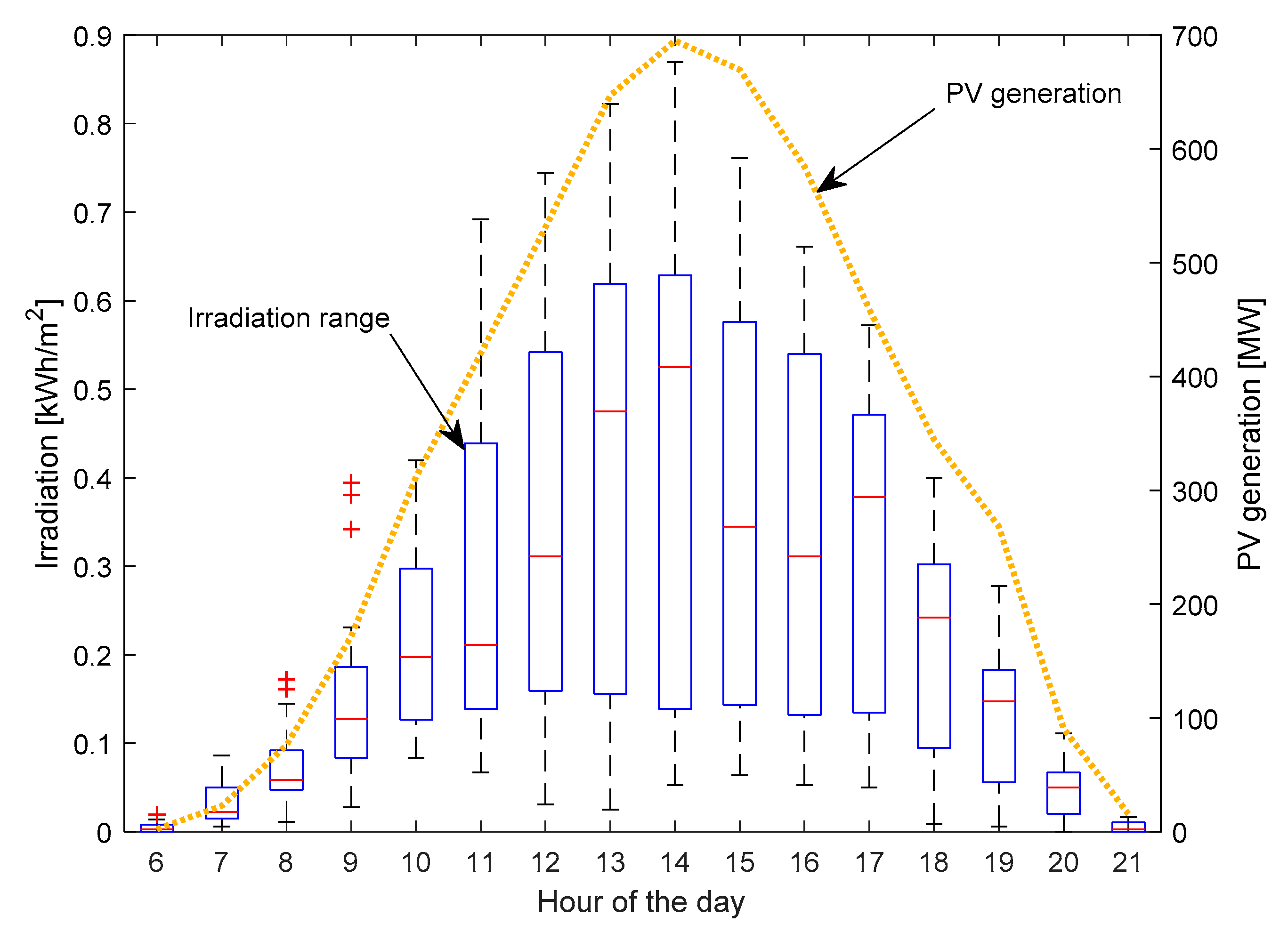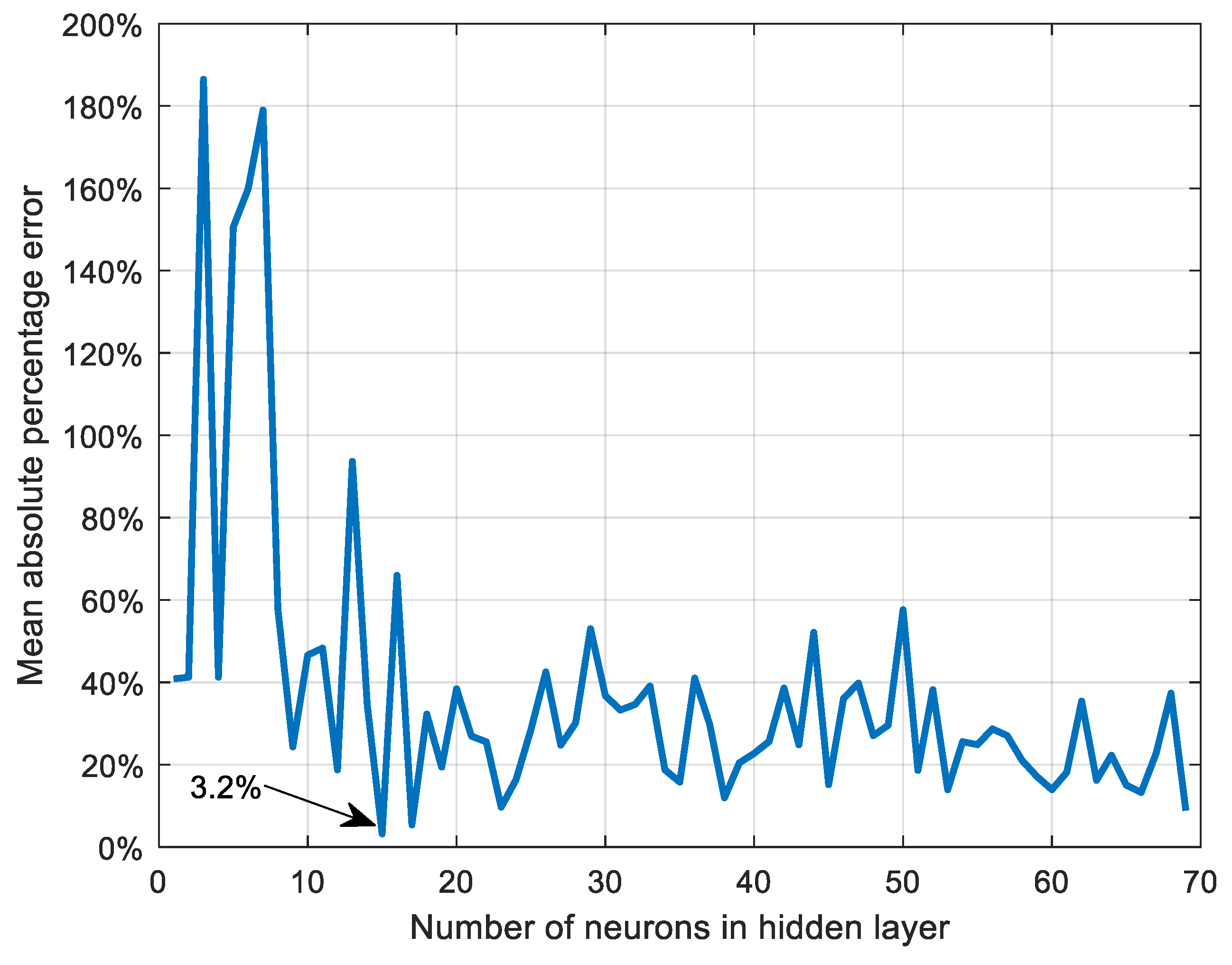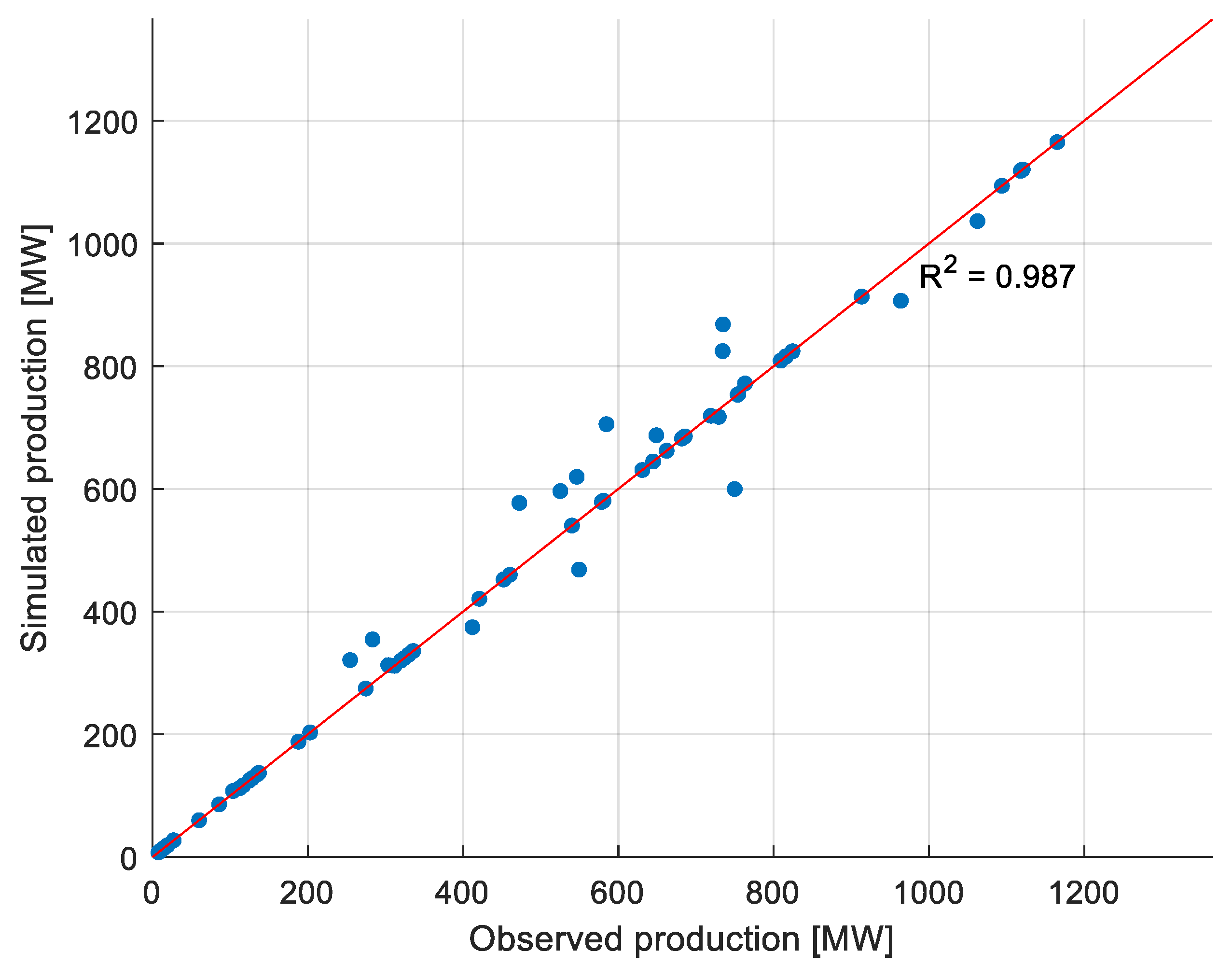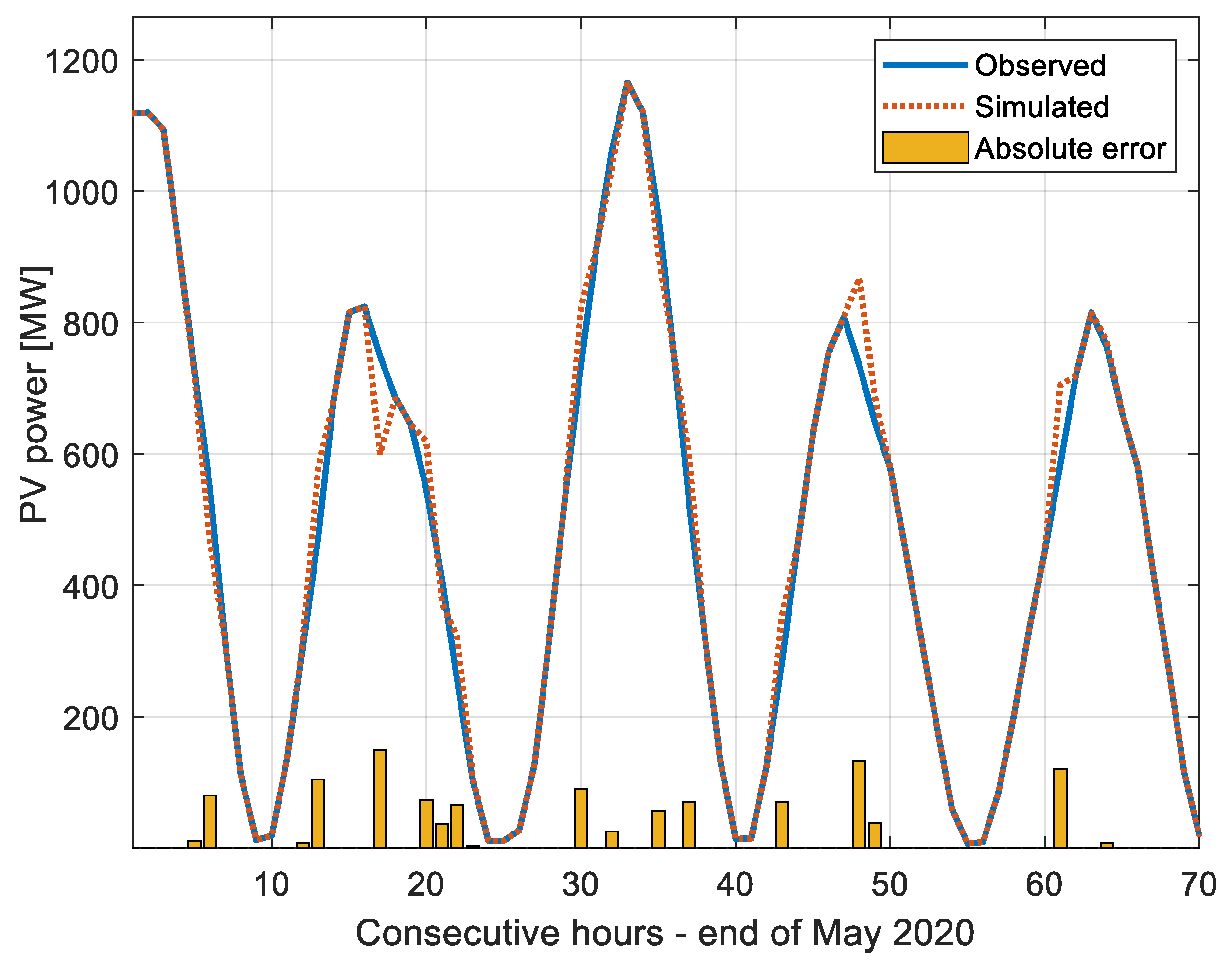Simulating Power Generation from Photovoltaics in the Polish Power System Based on Ground Meteorological Measurements—First Tests Based on Transmission System Operator Data
Abstract
1. Introduction
2. Materials and Methods
3. Results and Discussion
4. Conclusions
Author Contributions
Funding
Conflicts of Interest
Nomenclature
| ANN | Artificial Neural Network |
| ECMWF | European Centre for Medium-Range Weather Forecasts |
| ERA5 | ECMWF Reanalysis 5th Generation |
| IMWM-NRI | Institute of Meteorology and Water Management—National Research Institute |
| MAPE | Mean Absolute Percentage Error |
| MERRA | Modern Era Retrospective-Analysis for Research and Applications |
| NN | Neural Network |
| PS | Power System |
| PSE | pol. Polskie Sieci Elektroenergetyczne—Polish Transmission System Operator |
| PV | Photovoltaic |
| RMSE | Root-Mean-Squared Error |
| VRES | Variable Renewable Energy Sources |
References
- Augustyn, A.; Kamiński, J. Rola generacji wiatrowej w pokryciu zapotrzebowania na moc w krajowym systemie elektroenergetycznym [The role of wind power generation in the load carrying capability]. Rynek Energii 2018, 1, 47–52. [Google Scholar]
- Kacejko, P.; Wydra, M. Energetyka wiatrowa w Polsce-analiza potencjalnych ograniczeń bilansowych i oddziaływania na warunki pracy jednostek konwencjonalnych [Wind energy in Poland-Analysis of potential power system balance limitations and influence on conventional power units operational conditions]. Rynek Energii 2011, 93, 25–30. [Google Scholar]
- Kacejko, P.; Wydra, M. Nowa metoda szacowania możliwości przyłączeniowych generacji wiatrowej w KSE z uwzględnieniem ograniczeń bilansowych [A new method for estimating connection potential of wind power into National Power System with power balancing constraints]. Przegląd Elektrotechniczny 2014, 90, 32–35. [Google Scholar]
- Paska, J.; Kłos, M. Elektrownie wiatrowe w systemie elektroenergetycznym-przyłączanie, wpływ na system i ekonomika [Wind power plants in electric power system–Connecting, influence on the system and economics]. Rynek Energii 2010, 1, 3–10. [Google Scholar]
- Paska, J. Elektrownie wiatrowe w systemie elektroenergetycznym i ich zdolność do pokrywania obciążenia [Wind power plants in electric power system and their load carrying capability]. Przegląd Elektrotechniczny 2009, 85, 224–230. [Google Scholar]
- Jurasz, J.; Canales, F.A.; Kies, A.; Guezgouz, M.; Beluco, A. A review on the complementarity of renewable energy sources: Concept, metrics, application and future research directions. Sol. Energy 2020, 195, 703–724. [Google Scholar] [CrossRef]
- Olauson, J.; Bergkvist, M. Modelling the Swedish wind power production using MERRA reanalysis data. Renew. Energy 2015, 76, 717–725. [Google Scholar] [CrossRef]
- Olauson, J. ERA5: The new champion of wind power modelling? Renew. Energy 2018, 126, 322–331. [Google Scholar] [CrossRef]
- Black, J.; Hoffman, A.; Hong, T.; Roberts, J.; Wang, P. Weather data for energy analytics: From modeling outages and reliability indices to simulating distributed photovoltaic fleets. IEEE Power Energy Mag. 2018, 16, 43–53. [Google Scholar] [CrossRef]
- Adamowski, J.; Karapataki, C. Comparison of multivariate regression and artificial neural networks for peak urban water-demand forecasting: Evaluation of different ANN learning algorithms. J. Hydrol. Eng. 2010, 15, 729–743. [Google Scholar] [CrossRef]
- Piasecki, A.; Jurasz, J.; Adamowski, J.F. Forecasting surface water-level fluctuations of a small glacial lake in Poland using a wavelet-based artificial intelligence method. Acta Geophys. 2018, 66, 1093–1107. [Google Scholar] [CrossRef]
- Sharifzadeh, M.; Sikinioti-Lock, A.; Shah, N. Machine-learning methods for integrated renewable power generation: A comparative study of artificial neural networks, support vector regression, and Gaussian Process Regression. Renew. Sustain. Energy Rev. 2019, 108, 513–538. [Google Scholar] [CrossRef]
- Shabairou, N.; Cohen, E.; Wagner, O.; Malka, D.; Zalevsky, Z. Color image identification and reconstruction using artificial neural networks on multimode fiber images: Towards an all-optical design. Opt. Lett. 2018, 43, 5603–5606. [Google Scholar] [CrossRef] [PubMed]
- Cohen, E.; Malka, D.; Shemer, A.; Shahmoon, A.; Zalevsky, Z.; London, M. Neural networks within multi-core optic fibers. Sci. Rep. 2016, 6, 1–14. [Google Scholar] [CrossRef] [PubMed]
- Li, F.; Ren, G.; Lee, J. Multi-step wind speed prediction based on turbulence intensity and hybrid deep neural networks. Energy Convers. Manag. 2019, 186, 306–322. [Google Scholar] [CrossRef]
- Renno, C.; Petito, F.; Gatto, A. ANN model for predicting the direct normal irradiance and the global radiation for a solar application to a residential building. J. Clean. Prod. 2016, 135, 1298–1316. [Google Scholar] [CrossRef]
- Al-Dahidi, S.; Ayadi, O.; Alrbai, M.; Adeeb, J. Ensemble approach of optimized artificial neural networks for solar photovoltaic power prediction. IEEE Access 2019, 7, 81741–81758. [Google Scholar] [CrossRef]
- Çelik, Ö.; Teke, A.; Yildirim, H.B. The optimized artificial neural network model with Levenberg–Marquardt algorithm for global solar radiation estimation in Eastern Mediterranean Region of Turkey. Clean. Prod. 2018, 116, 1–12. [Google Scholar] [CrossRef]
- Sheela, K.G.; Deepa, S.N. Review on methods to fix number of hidden neurons in neural networks. Math. Problems Eng. 2013, 2013. [Google Scholar] [CrossRef]
- Marcos, J.; Marroyo, L.; Lorenzo, E.; García, M. Smoothing of PV power fluctuations by geographical dispersion. Prog. Photovolt. Res. Appl. 2012, 20, 226–237. [Google Scholar] [CrossRef]
- Engeland, K.; Borga, M.; Creutin, J.D.; François, B.; Ramos, M.H.; Vidal, J.P. Space-time variability of climate variables and intermittent renewable electricity production–A review. Renew. Sustain. Energy Rev. 2017, 79, 600–617. [Google Scholar] [CrossRef]
- Schyska, B.U.; Kies, A. How regional differences in cost of capital influence the optimal design of power systems. Appl. Energy 2020, 262, 114523. [Google Scholar] [CrossRef]






| No. | Meteorological Element | Sensor Type | |||
|---|---|---|---|---|---|
| 1 | Irradiation | KIPP & ZONEN CNR4 Net Radiometer | KIPP & ZONEN CMP11 Pyranometer | X | X |
| Location | Piła, Łeba | All 21 others | X | X | |
| 2 | Air temperature | Pt 100 PVC | Vaisala QMT 103 | Vaisala QMT 110 | Vaisala HMP45A/45D |
| Location | Radzyń, Warszawa-B., Legionowo, Jarczew, Kasprowy W., Wieluń, Zakopane, Łódź, Włodawa, Suwałki | Łeba, Koło, Bielsko-B., Piła, Gorzów W., Sulejów, Mikołajki | Toruń, Koszalin, Legnica, Jelenia G., Kłodzko | Gdynia | |
| 3 | Wind speed | Vaisala Ultrasonic WS 425 | Vaisala Cup Anemometer WAA 151 | Gill Instruments WindSonicM | Others (Vaisala WMS 302, WMT 700, 702, 703 and G. Lufft WS 200-UMB |
| Location | Gorzów W., Jelenia G., Kłodzko, Koszalin, Legnica Łódź, Mikołajki, Piła, Sulejów, Suwałki, Wieluń, Włodawa, Zakopane | Gdynia, Radzyń, Warszawa-B. | Toruń, Legionowo | Jarczew, Kasprowy, Łeba, Koło, and Bielsko-B. | |
© 2020 by the authors. Licensee MDPI, Basel, Switzerland. This article is an open access article distributed under the terms and conditions of the Creative Commons Attribution (CC BY) license (http://creativecommons.org/licenses/by/4.0/).
Share and Cite
Jurasz, J.; Wdowikowski, M.; Figurski, M. Simulating Power Generation from Photovoltaics in the Polish Power System Based on Ground Meteorological Measurements—First Tests Based on Transmission System Operator Data. Energies 2020, 13, 4255. https://doi.org/10.3390/en13164255
Jurasz J, Wdowikowski M, Figurski M. Simulating Power Generation from Photovoltaics in the Polish Power System Based on Ground Meteorological Measurements—First Tests Based on Transmission System Operator Data. Energies. 2020; 13(16):4255. https://doi.org/10.3390/en13164255
Chicago/Turabian StyleJurasz, Jakub, Marcin Wdowikowski, and Mariusz Figurski. 2020. "Simulating Power Generation from Photovoltaics in the Polish Power System Based on Ground Meteorological Measurements—First Tests Based on Transmission System Operator Data" Energies 13, no. 16: 4255. https://doi.org/10.3390/en13164255
APA StyleJurasz, J., Wdowikowski, M., & Figurski, M. (2020). Simulating Power Generation from Photovoltaics in the Polish Power System Based on Ground Meteorological Measurements—First Tests Based on Transmission System Operator Data. Energies, 13(16), 4255. https://doi.org/10.3390/en13164255







